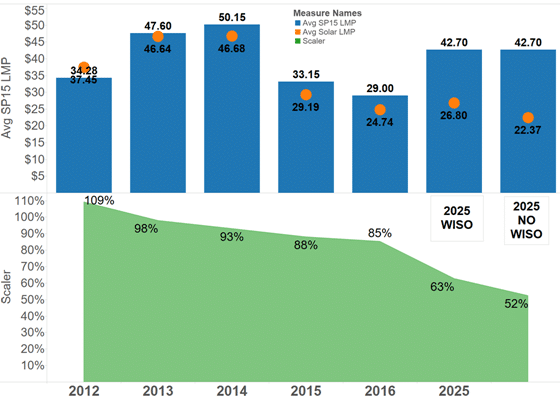An integrated market would drop the cost of wind and solar integration, and make buying wholesale renewables a lot easier
What would an expansion of the California wholesale market to a broader Western regional market mean for businesses looking to buy renewable energy?
We recently tried to answer that question at a seminar. After a stimulating discussion with representatives from Fix the Grid, Energy GPS, MISO, and Bay Area-based corporate buyers, our takeaway is that a regional Western grid would increase the opportunity to contract for cost-effective renewable energy.
It’s well known that the installed cost of wind and solar has declined dramatically over the past several years; Lazard’s Levelized Cost of Energy Analysis 9.0 quotes a decline of 60 percent and 80 percent since 2009, respectively.
This cost-competitiveness has been a driver of the increased corporate interest in buying renewable energy via physical or virtual power purchase agreements to support their sustainability or greenhouse gas (GHG) emission reduction strategies. The creation of a Western RSO (an aggregation of state markets in Washington, Oregon, California, Nevada, Colorado, Utah and Arizona) would change the landscape for renewable energy buyers in a few different ways.
The creation of a Western RSO would change the landscape for renewable energy buyers.
A Western RSO would lower the cost of integrating renewable generation
In order to accommodate intermittent generation, the grid needs flexibility. Wind and solar cause significant “noise” in the energy system throughout the day based on the weather conditions that exist. In order to manage this intermittency, the system operator must create financial incentives for flexible and ramping products to help smooth out variability (i.e., natural-gas-fired power plants, energy storage, demand response). The operational costs of these flexible generation and load resources equate to the cost of integrating renewables.
A geographically diverse regionalized grid would increase efficiency and decrease integration costs. The amount of flexible resources required for reliability would decrease in proportion to the overall system size because the impact of localized weather events and the corresponding spikes or plunges in renewable generation are less pronounced when the supply and demand on the system are spread across a larger physical area.
Since RSOs are revenue-neutral organizations, operational costs are spread across all generators via grid charges. A decrease in the cost of integrating intermittent resources would result in lower operating costs for renewable generators, allowing developers to pass through a more competitive PPA price to the buyer.
A Western RSO would increase the value of renewable energy in the wholesale market
Once a seller and a buyer agree to a PPA price, the buyer reaps the benefit of the energy price and the renewable energy certificate price in the market. In CAISO, the value of renewables, specifically solar, has decreased over time as more generation has been integrated into the system. This is largely due to oversupply when the sun is shining.
FIGURE: Historical and Projected Wholesale Market Value of Solar in 2025 With and Without a Western ISO (WISO)
<img=”https://3degreesinc.com/wp-content/uploads/2024/07/27fd1915-e055-4222-8b4c-916764513712.png”>
Source: Energy GPS
Before significant solar capacity was installed, periods of high solar production were closely correlated with periods of high energy usage (hot days mean more air conditioning) and peak electricity prices. Now, with more than 10 gigawatts of solar installed across CAISO, the periods of maximum solar output more frequently correspond with low or negative wholesale prices.
The degraded solar value is problematic for businesses that may be buying solar via a virtual PPA, under which they benefit from wholesale prices above the PPA rate but are required to pay the delta when wholesale prices fall below the PPA rate. Within a Western RSO, it would be easier to move power around the grid thanks to alternate transmission paths, and renewables can become a cost-effective export during periods of over-generation.
Analysis from Energy GPS estimates that the average wholesale price for solar in 2025 would be ~120 percent higher if the West moved to a regionalized grid.
A Western RSO would allow for a broader array of transaction structures for corporate buyers
By expanding CAISO market constructs to neighboring states, physical purchases and virtual PPAs would be available to buyers throughout the Western grid.
Under the current grid structure, a business that is interested in purchasing Washington wind via a virtual PPA is likely to transact at the Mid-Columbia trading hub (one of two liquid points in the Pacific Northwest). The buyer would bear the costs associated with delivering and liquidating power to the trading hub, including transmission, logistics, and the bid/offer spread.
Additionally, the buyer would be subject to pricing at Mid-Columbia that is less reliable and more at risk of volatility than a hub within an independent system operator (ISO) territory; Mid-Columbia is an “informal” hub and lacks the formal market rules that come with an ISO.
Alternatively, a similar project in CAISO would face none of the delivery costs and would be earning revenue from capacity payments (resource adequacy). The buyer would also benefit from greater wholesale price certainty at a hub that is subject to ISO market rules (such as NP-15 or SP-15). If both projects started at the same price, the CAISO project could be delivered at a lower cost to the corporate buyer. Moving to a Western RSO would increase the availability of cost-effective transaction structures for corporate buyers across the Western grid.
As detailed above, the creation of a regionalized Western grid would be beneficial for businesses looking to purchase cost-competitive renewable energy and decrease their Scope 2 GHG emissions. When considering renewable energy purchases in the West, corporate buyers should also keep in mind that an expanded RSO will allow for a cleaner grid overall — integrating renewables across a broader geographic region can reduce the need for redundant baseload resources and support the shutdown of fossil generation.
With a regionalized Western grid, there will be more options for buying cost-effective renewables, and the energy from your utility will be less carbon-intensive. In our opinion, these benefits add up to a very compelling case for business to support an expanded RSO.
With federal climate policy uncertain, it is increasingly important for renewable adoption to be driven by cities, states and the private sector.
For more information on the Western RSO, visit www.fixthegridwest.org.
Originally published on GreenTechMedia
More on 3Degrees +


